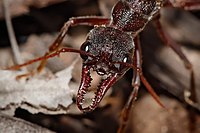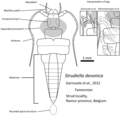
Back بوابة:حشرات Arabic প্রবেশদ্বার:কীটপতঙ্গ Bengali/Bangla Portál:Entomologie Czech Portail:Entomologie French Portal:昆虫 Japanese 포털:곤충 Korean Vikisritis:Vabzdžiai Lithuanian Portaal:Insecten Dutch Portal:Entomologia Portuguese Portal:Entomologie Romanian
The Insects Portal


Insects (from Latin insectum) are hexapod invertebrates of the class Insecta. They are the largest group within the arthropod phylum. Insects have a chitinous exoskeleton, a three-part body (head, thorax and abdomen), three pairs of jointed legs, compound eyes, and a pair of antennae. Insects are the most diverse group of animals, with more than a million described species; they represent more than half of all animal species. (Full article...)
Selected article -
Did you know -
- ... that species in the fossil ant genus Myrmeciites are named for Hercules, Goliath, and a river?
- ... that Euploea alcathoe, the common crow butterfly, may pass through several generations in a year?
- ... that the female sand wasp Ammophila sabulosa digs burrows in sandy ground, provisioning each burrow with a food supply of paralysed caterpillars, always laying one egg on the first caterpillar?
- ... that larvae of the toadfly make their way through the nostrils of the common toad and eat its flesh?
- ... that the rice stink bug, a major pest of rice kernels, can possibly be ignored when found on standing maize?
List articles
Related portals
General images -
Selected image -

Simosyrphus grandicornis is an Australasian species of hoverfly (Diptera: Syrphidae), and is one of the two most common hoverflies in Australia, alongside Melangyna viridiceps. Pictured above is a pair of S. grandicornis mating in flight.
WikiProjects

Main WikiProject:
Related projects:
- WikiProject Arthropods
- WikiProject Spiders
- WikiProject Animals
- WikiProject Tree of Life
- WikiProject Biology
Daughter projects:
Tasks
 |
Here are some tasks awaiting attention:
|
Associated Wikimedia
The following Wikimedia Foundation sister projects provide more on this subject:
-
Commons
Free media repository -
Wikibooks
Free textbooks and manuals -
Wikidata
Free knowledge base -
Wikinews
Free-content news -
Wikiquote
Collection of quotations -
Wikisource
Free-content library -
Wikiversity
Free learning tools -
Wiktionary
Dictionary and thesaurus



















































